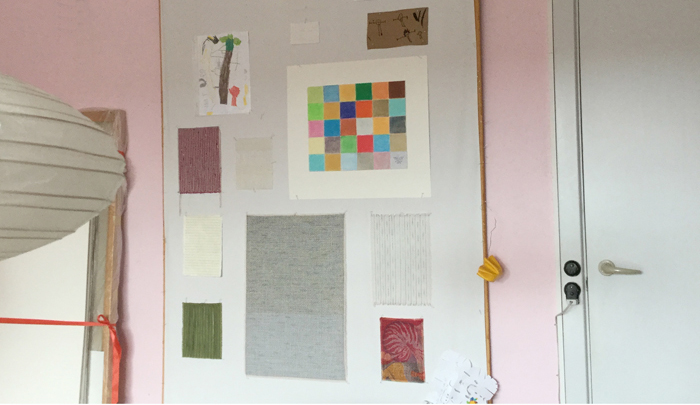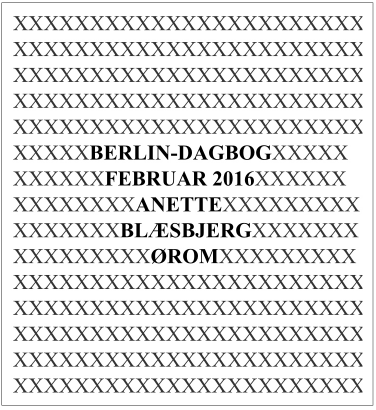THE BEGINNING
I was introduced to knitting, weaving and embroidery during my childhood, and I was thrilled; I also became interested in pictorial art at an early age. I later applied to study at the Schools of Visual Arts at the Royal Danish Academy of Fine Arts in Copenhagen; I was admitted to the School of Painting.
PAINT, OIL PASTEL, TEXTILE
At first, I worked in oil pastel and paint. Towards the end of my studies, however, I started using textile media as my chosen form of artistic expression; to begin with via tapestry, and then I gradually worked my way into the use of textiles. My process of experimentation initially involved classic craft techniques – including, for example, netting, a delicate technique related to the knotting of fishing nets. I developed a special way of working with colour, which led quite literally to a layer-upon-layer effect. For example, I started weaving with coloured warp thread on my loom, which provided a basic tone to the tapestry in the same way as a canvas might have a painted ochre undercoat, and with the texture allowing a glimpse of the warp colour to show through. When embroidering, I might sew in various layers to achieve the desired quality of colour and specific textural effect, the two being closely linked. I have at times combined my techniques – for example, by applying thin layers of acrylic paint to cloth I have woven and then embroidered.

CRAFT/ART/EXPRESSION
I consider the actual craft to be an ingredient of artistic articulation. When weaving, the overall picture is built up by means of modules, and these modules can be assembled within a particular rhythm. This is also the case when sewing, embroidering: slanting stitches, for example, are endowed with rhythm, and by varying the size, changing direction, those rhythms are breached. The craft thus becomes an element of the artistic expression. Technique has to be skilfully executed, but a good and neat technique should certainly not be an end in itself – it should be the means to an end.
THEMATIC UNIVERSE
I draw great inspiration from nature, from landscapes and the flora of our world. The intense experience can be defining in itself. Encountering a desert landscape, for example, is an experience both of texture and of colour, and a wild flower meadow has both structure and colour distribution, a buoyancy and a spirit. Moreover, I work from a basis of simple mathematical principles such as rhythm and sequence, numerical sequence and tabular form, and also mathematics as I experience it indirectly through contemporary classical music. I am fascinated by the use of theories and systems in the work of composers such as, for example, George Crumb and Per Nørgård. I am intrigued by this musical world, in which a form of stringency and simplicity becomes dynamic. The blending of chance and precision also appeals to me. I often experience music as structure; and modern jazz, for example, as distinctly spatial. Music provokes pictorial associations that are also central to my thematic universe. Nature, like music, is full of mathematical structures and geometric forms.

BOOKS
My long-standing interest in literature also applies to the book as object. In 2003, I made a catalogue for an exhibition in Stensalen (part of Designmuseum Danmark [Danish Museum of Art & Design]), At lytte til lærken [Listening to the Skylark], which became an independent little book with poems by Eske K. Mathiesen and reproductions of eleven of my small-scale pieces. In 2008, I had the idea for a book relating to a piece I had made – Verdens klang [The Sound of the World] – which had been inspired by a collection of essays on music written by Karl Aage Rasmussen, Har verden en klang [Does the World have a Certain Sound]. My piece comprises five sections of white fabric and consists solely of horizontal and vertical lines: with two tones of blue thread in the blue section, two tones of red thread in the red section, a bronze and an orange tone in the orange section, one green-coloured thread in the green section, and a yellow section with a dark deep-red thread in a sequence of yellow threads. The book shows twelve details from the five sections. Eske again provided the words: in this instance, a poem running throughout the book, Souvenir. In 2016, I published Pastorale, also the result of an inspiring collaborative process, although Eske’s texts are not focussed specifically on my pieces; the book works on two levels playing together. I undertook all the preparatory work prior to the actual printing of the books, and I have continually reaped know-how in the field of book production through my freelance association with the publishing house Borgens Forlag/Borgen Gyldendal (2002-2015).
Anette Blæsbjerg Ørom, May 2017
Up ^
